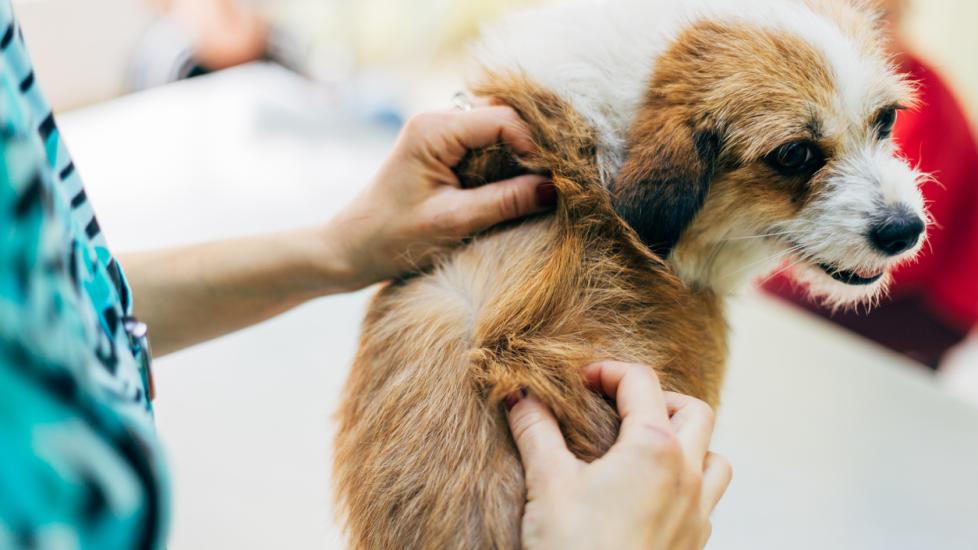Walking Dandruff in Dogs
The following may contain Chewy links. PetMD is operated by Chewy.
What Is Walking Dandruff in Dogs?
“Walking dandruff” is the common name for cheyletiellosis, a skin disease in dogs caused by the Cheyletiella mite.
Cheyletiella is a contagious skin parasite that results in scaling of the skin. Sometimes, in a severe infestation, the white mites can be seen walking across the skin, hence the nickname “walking dandruff.”
Cheyletiellosis affects dogs, cats, rabbits, and humans. Due to regular flea-and-tick-prevention product use, Cheyletiella is not a common parasite. These products are not labeled specifically for Cheyletiella mites, but they may reduce a pet’s risk of contracting walking dandruff. Cheyletiellosis is more commonly found in puppies and kittens in unclean or less sanitary conditions or in kennels.
If left untreated, cheyletiellosis may lead to more severe skin infections and chronic skin disease. When the immune system is busy fighting chronic inflammation, it allows secondary bacteria and yeast to grow. This may result in excessive scaling, hair loss, itching, and discomfort.
Symptoms of Walking Dandruff in Dogs
The most common sign of walking dandruff in dogs is white flakes on the skin and coat. The presence of white mites contributes to the appearance of excessive dandruff.
Keep in mind that most pets with walking dandruff do not scratch a lot. However, they may have an allergic reaction to the Cheyletiella mite and become very itchy. They may also develop scaly, crusty skin, especially on their back. Sneezing may also accompany a Cheyletiella infestation in some dogs.
Causes of Walking Dandruff in Dogs
As noted, walking dandruff is caused by Cheyletiella mites. These mites are very contagious and are most often found in large kennels, boarding facilities, groomers, or where dogs have close contact with other dogs.
The mite lives on the hair, only visiting the skin to feed. The mite spends most of its life on the pet but can survive in the surrounding environment for up to 10 days. An infected pet’s bedding or a kennel they have been in can be a source of infection to other pets.
Walking dandruff is a zoonotic disease, an infection that can be spread between animals and humans. So, other pets and humans in your household are at risk of contracting the Cheyletiella mite from an infected pet. Fortunately, humans are not the preferred host for this parasite. Symptoms of human infection are itchy, red bumps that usually resolve after the pet is properly treated.
If your pet is diagnosed with walking dandruff, talk to your healthcare provider about any recommended testing and treatment for you and your family.
How Veterinarians Diagnose Walking Dandruff in Dogs
The most common tests veterinarians use to diagnose walking dandruff are skin scrapes and acetate tape preparations. A skin scrape is a procedure that uses a small blade to scrape cells off the surface of your dog’s skin to determine the type of mite. During an acetate tape preparation, your vet uses a piece of tape to collect flakes of dandruff from your pet’s coat, places them on a microscope slide, and looks for Cheyletiella mites.
Other skin tests that are commonly used include:
-
A Wood’s lamp examination using ultraviolet (UV) light, or blacklight
-
Fungal cultures where hairs are plucked and placed in a growth medium
-
Skin cytology from impression smears, scrapes, or plucks
-
Bloodwork to rule out underlying thyroid disease or other endocrine conditions
-
Skin biopsies
Treatment of Walking Dandruff in Dogs
There are several treatments for cheyletiellosis in dogs, including topical treatments:
-
Lime sulfur baths
-
Topical flea and tick spot-on (Revolution, Frontline)
-
Spray (Frontline spray) products
-
Oral medications, including Trifexis, Sentinel, and Heartgard
Your veterinarian can help guide treatment of your pet. Remember that all animals in the home (dogs, cats, and rabbits) exposed to Cheyletiella should be treated.
Some treatments are safe for some dogs but not for cats, rabbits, and certain dog breeds or ages. Ask your veterinarian which treatment is best for your pet and follow the instructions. Do not discontinue a treatment before it is completed.
In addition to treating all pets in your household, it is important to treat the environment as well. Remember that Cheyletiella can survive off the animal and in the environment for up to 10 days. Wash all bedding your pet sleeps on with hot water and detergent. Thoroughly clean the house using cleaners that are designed to treat fleas and remove adult mites, and follow the directions on the product label.
If a pet’s bedding is not washed or all pets in the household are not treated, repeat infections can occur. Also, some animals can be silent carriers and have mites on their coat, but they may not show obvious clinical signs of cheyletiellosis.
Pets are no longer contagious 3 weeks after treatment. Most treatment programs last at least 3 weeks.
Recovery and Management of Walking Dandruff in Dogs
The prognosis for recovery from cheyletiellosis, or walking dandruff, is excellent when it is treated appropriately. Walking dandruff in humans heals with time, even without treatment, because humans are accidental hosts, and the infection resolves itself.
Untreated pets will continue to be infected with Cheyletiella mites for the long term and may develop chronic skin disease and secondary skin infections.
Dogs that have been infected and treated can become infected again if they are re-exposed. Having cheyletiellosis does not make them more likely to get it in the future unless they are re-exposed to an untreated source.
Prevention of Walking Dandruff in Dogs
Many flea and tick products that are on the market today, such as fipronil (Frontline) and selamectin (Revolution), are very effective against walking dandruff in dogs.
To reduce your pet’s risk of contracting walking dandruff, keep them up to date on their topical or oral flea and tick preventative medication.
References
Help us make PetMD better
Was this article helpful?
